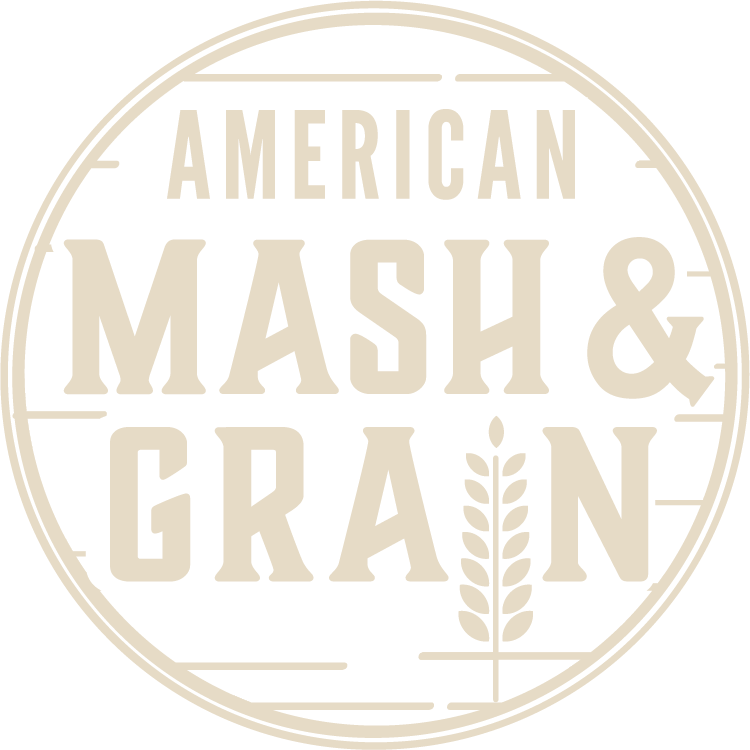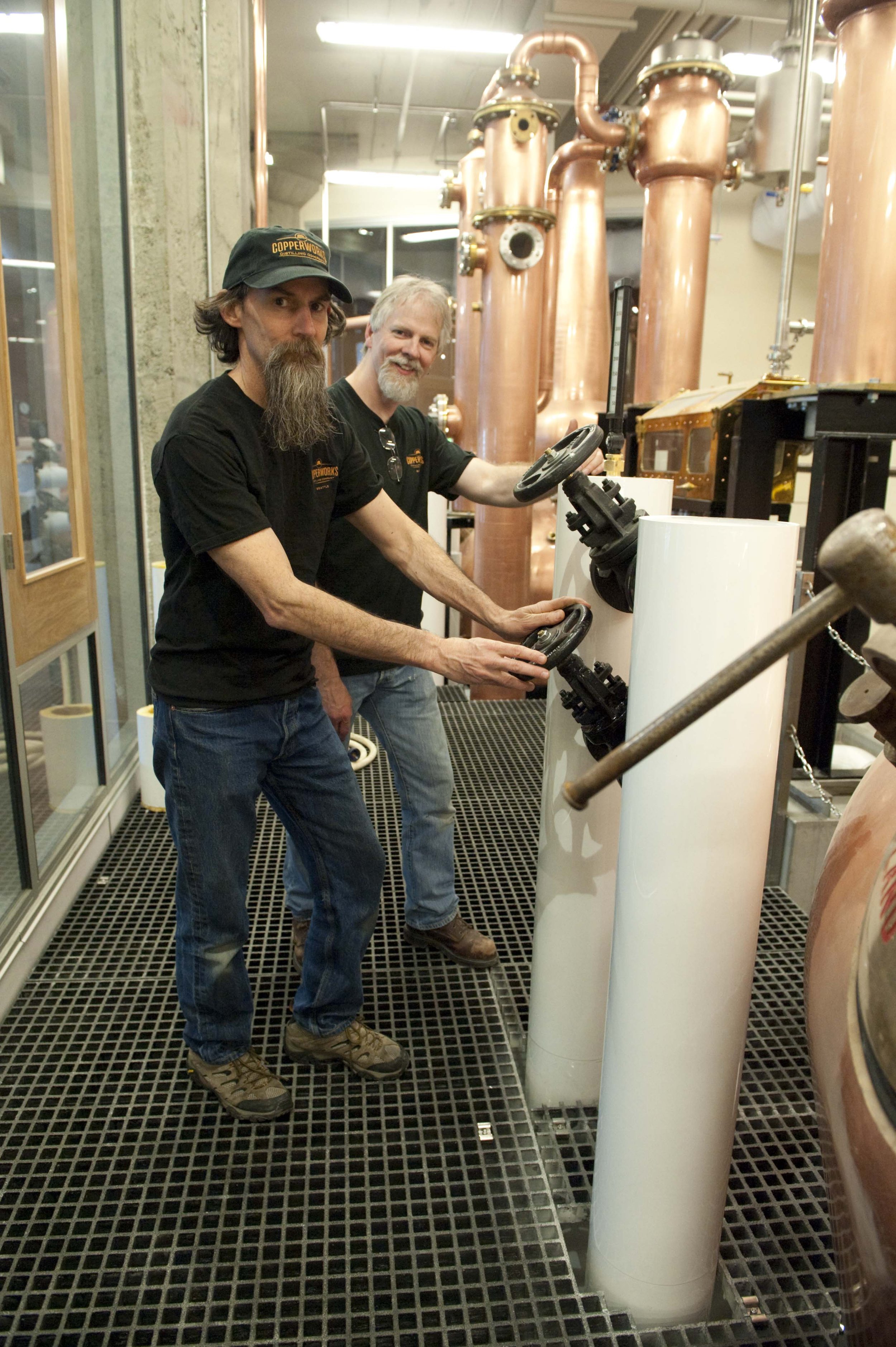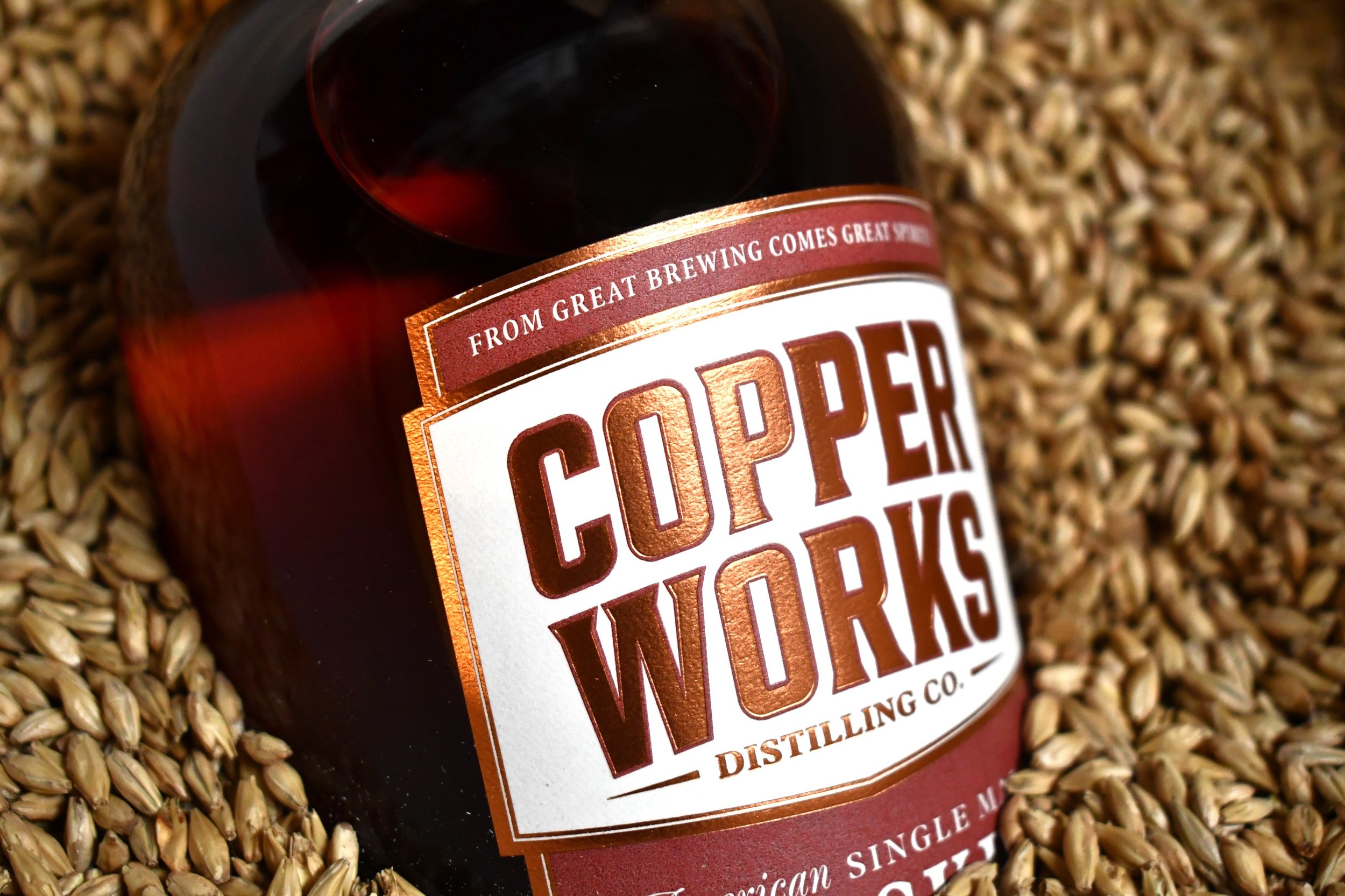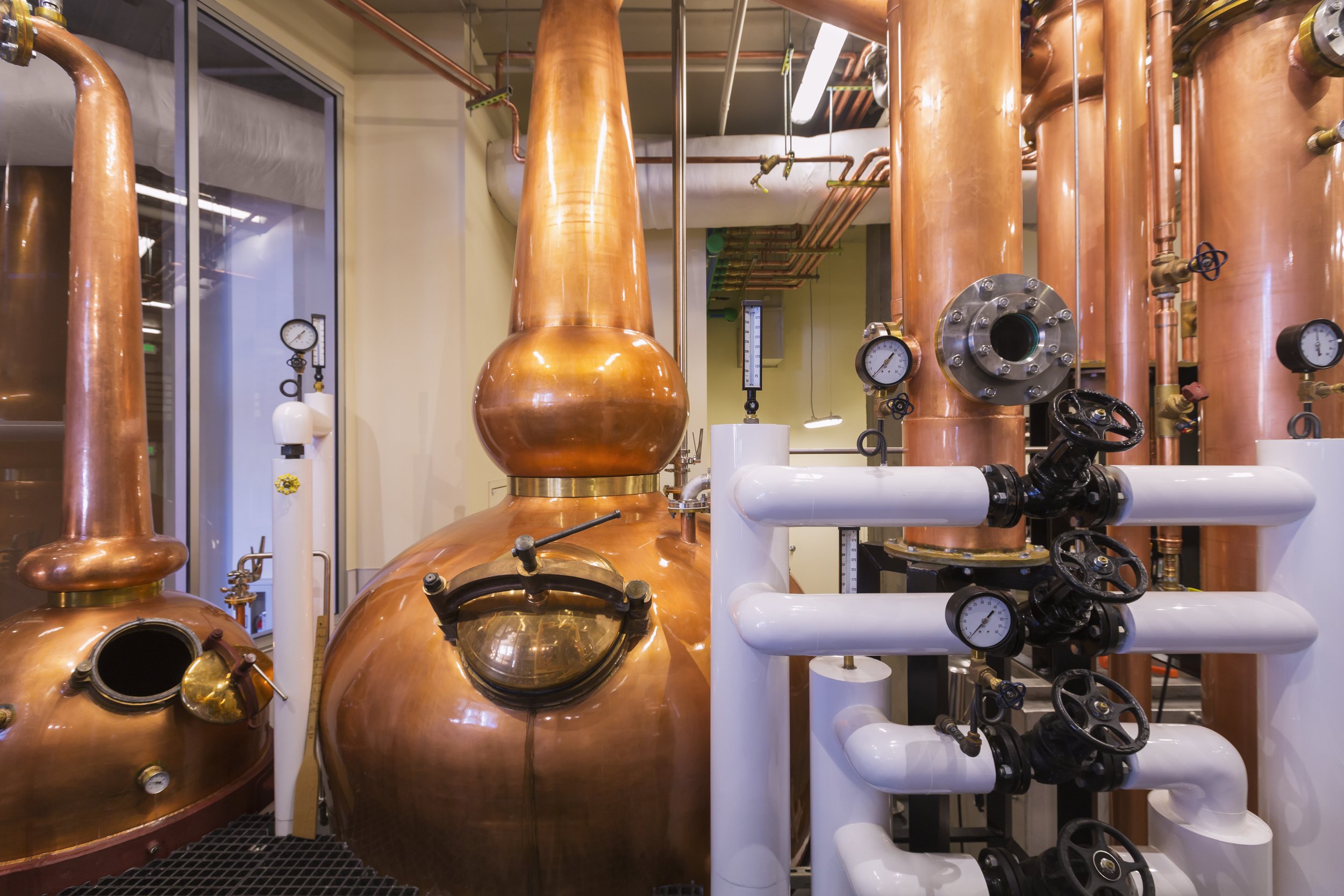Copperworks Distilling
By Meghan Swanson
The right people, in the right place, at the right time; it’s the foundational dream for any good rom-com. Less well-known is the fact that it’s also a foundational dream for a successful business. The story of Jason Parker’s journey to co-founding Copperworks Distilling would make any dreamer swoon, whether they’re into Tom Hanks or Bill Gates. Drawn to the Pacific Northwest from his home state of Kentucky by a passionate love for the outdoors, Jason ended up at Evergreen State College in Olympia, Washington—also known as ‘Ever-Groovy’ for its no-grades approach to education—and on a path that would take him from aspiring environmental educator to titan of the burgeoning Seattle craft brewing scene, and eventually to the helm at Copperworks.
“That’s when they said, ‘You know what, we're opening a brewery in Seattle in the Pike Place Market. We're going to call it Pike Place Brewery…we're looking for a brewer who has more than just a casual interest in home brewing…and we'd like you to apply.’”
Jason has been interested in beverage alcohol from a young age; he started home brewing at the age of 16 in his hometown of Bowling Green, Kentucky. When his parents found out, instead of punishing young Jason, they made it into a family activity and began brewing with him. Jason attended Evergreen State College in Olympia, Washington. In the summer of 1986, Jason asked Evergreen to sponsor a “contract” where he would receive college credit for studying the Campaign for Real Ale (CAMRA) and compare it to the emerging Northwest craft brewing scene. “I was getting 16 hours of credit for drinking beer, talking to brewers…it was great, great fun.” He recalls fondly. In the north of Scotland, Jason visited Traquair House Brewery; a tiny operation tucked beneath one wing of the venerable Traquair House (according to its website, Scotland’s Oldest Inhabited House), it was the passion project of the 20th Laird of Traquair, Peter Maxwell Stuart. The laird told Jason the story of how he’d discovered the old brewhouse, nearly intact, after some spring cleaning had cleared away the decades of furniture hiding Traquair’s brewing history. Jason took this incredible story—and a t-shirt—home with him along with the rest of his CAMRA experience. “That changed my focus forever,” he tells us.
Back home, Jason was standing in the homebrew aisle of the University of Washington bookstore one day when he became aware of another customer nearby, his eyes scanning the same shelves. “Are you a homebrewer?” asked the stranger.
“Yes, I’ve been doing it for about a dozen years now.” Jason replied. “Are you?”
“I’m involved in it.” The stranger replied. What an odd answer, Jason thought.
As it turns out, the man was Charles Finkel, owner of Merchant du Vin. Charles waved over his wife, Roseanne, and during their conversation (discussing breweries that the Finkels carried and brewers they all knew), she mentioned a tiny brewery from northern Scotland she was working hard to bring in. Jason wordlessly lifted his sweatshirt to show them the t-shirt he happened to be wearing that day: the one he’d bought at Traquair House Brewery on his visit. “So at that moment, there's three people in America who know about this brewery, and we're all talking to each other.” Jason exclaims.
That was the moment Roseanne and Charles asked Jason to apply for a position at their nascent brewery—the pillar of Seattle craft brewing known as Pike Brewing Company, still going strong today. “My resume was two bottles of beer,” Jason tells us. They couple asked how much Jason was looking to get paid, and the star-struck beer fan simply said ‘minimum wage’. They hired him to be their first brewer. “To this day, brewers in Seattle still get paid less than anybody else.” He says with a rueful grin. Jason quit school and spent the next two years helping to open up Pike Brewing. His education didn’t end, however; his contract with Roseann and Charles specified that he was to go back to school and get his degree in chemistry. After three years, Pike still hadn’t opened, so Jason kept going, earning a degree in microbiology too. Eventually, he says, “They kicked me out of school. I had too many credits to keep going.” While he was in Olympia, he served as a consultant for the opening of Fish Tale Ales, another well-known Washington craft brewery still on shelves today.
Eventually, Jason ended up as head brewer at Pyramid Brewing—perhaps best known for their popular Apricot Ale—and spent eight years there. “But when we went public, and became a public company, we were no longer focused--in my opinion--on quality of beer, we were focused on shareholder wealth.” Jason explains. “I felt like we were making decisions that just weren’t of interest to me. The company had lost its shine.” He finishes. He was a highly qualified brewer, but there were no longer any places he wanted to brew at. Jason was not enthusiastic about his vision of the future of brewing; he got out and landed in information technology.
During his final year at Pyramid Brewing, Jason served as a subject matter expert for consultants putting together an MRP, or manufacturing resource plan. “So I spent a year at Pyramid helping create a flowchart of exactly what we did, creating bills of materials for all of the products, really understanding how the system worked, and then feeding them data and information in a structured way. We ended up with a great tool. And I really enjoyed the process.” He explains. One day, he followed his girlfriend Kathy to a job fair; she was just dropping off a resume, and he was dressed in a sweatshirt and jeans. “Folks were grabbing me and saying, ‘What do you do? Would you like a job?’” he recalls. “In 2000, if you had a heartbeat, you could get a job.” He jokes. The experience opened his mind to the idea that there were opportunities for him to do something other than brewing. In the Seattle Times’ want ads, Kathy found an opening at a dot com for a business analyst. Jason, remembering how much he enjoyed playing that role at Pyramid, applied and was hired. “I loved and really enjoyed that, got a master’s in information management at the University of Washington, and was definitely on the path to be an IT nerd forever.” He says.
“I had watched a lot of Boeing executives quit and try to open distilleries…I didn't feel like anybody had experience like I have in how to build up beverage alcohol manufacturing.”
In 2008, distilling became legal in the state of Washington, tempting Jason away from his continued bliss as an IT nerd. He wasn’t about to jump in with both feet, though: “I knew I couldn’t get into distilling if I didn’t have a pathway to bring my partner, Kathy, along. I saw too many people who lost their relationships by following their passion into this industry.” Jason tells us. He spent two more years working on a plan to open up a distillery and “bring her, mentally, along for the ride.” He explains. During that time, he learned that his old friend Micah Nutt had also been tossing around the idea of opening a distillery. “He and I had lived next door to each other as home brewers,” Jason explains. In the early 00s, they had lived in two houses on Eastlake in Seattle that were very close to each other, forming what Jason calls “almost like a hippie commune.”
The two houses coexisted as one. “You might find that the neighbor next door is cooking breakfast for everybody. And then some people are going to be over to your house that evening you know, hanging out all night, playing games or doing whatever.” He says. “I was a professional brewer. But he [Micah] was a spectacular home brewer.” Jason points out. “He's so good with his hands, such an engineer, such a craftsman. Anything he does, he's going to do perfectly. So we were making some pretty good beers.” He says. Brewing great beers together led them to tasting whiskey together, developing their palates for whiskey and sparking a shared interest in distilling. They had been in different business arenas all this time, but now they both had whiskey back on their minds. “And so, we decided together that we wanted to open up a distillery based on beer.” Jason remembers.
Together, Jason and Micah turned their considerable talents towards launching their new beer-based distillery. After a year and a half of working to get the distillery built, they knew they would also need someone to run their tasting room. A month before they opened their tasting room, fellow Seattle distiller Skip Tognetti called. He had a guy who had been working for him for the past 9 months—basically volunteering—trying to leap into distilling and get out of his unhappy career as a lawyer. “‘This guy needs a job, and you guys need to hire him,’” Jason recalls Skip saying. The guy in question, Jeff Kanof, became Copperworks’ first employee. Today, he is the distillery’s co-owner and vice president. “Micah retired about five and a half years ago,” Jason reveals; though Micah is still a co-founder and co-owner, he participates from more of a distance. “Jeff and I are now the people making the day-to-day decisions and strategies.” Jason finishes.
“Our main focus is to brew really high quality beer, just exactly the way a high quality craft brewer would do, with one exception: we don't add hops, and then we take that craft beer and put it in a still.”
Just as Scotland had provided Jason with inspiration at the beginning of his craft brewing career, it offered role models for his new distilling venture. Jason and Micah visited Scotland in early 2011 to meet with Forsythe Ltd. and select the stills for their new distillery. They toured ten different Scottish distilleries; at Balvenie, they found themselves quite taken with their boil ball style stills. “When Michah and I flew over, I took 20 little bottles of whiskey that I had identified as having something that I enjoyed, from a Scotch, from a bourbon, from a Tennessee, from a rye,” Jason tells us. Why did he bring all these samples, Forsyths wanted to know? Well, Jason explained, he wanted them to taste the flavors he’d picked out and help identify what kind of still he would need to produce something similar.
This was when Forsyths busted a distilling myth for Jason and Micah. “They said ‘Hey, have you ever heard the story that, if you have a hammer and you drop it and it makes a dent in your still you need to save that hammer? Because when we make you a new still, we're going to want to hit that same dent and create that same thing, because it'll affect the flavor?’” Jason recalls. “‘That’s bullshit.’ they said.” he says with a laugh. They advised that Jason and Micah 1) get over the idea that the still itself is a huge flavor contributor, 2) make their still pretty (since they’d be looking at it for the rest of their lives) and 3) make sure it fits in the building (You would not believe, they said, how many clients they’d sent stills to that couldn’t get them into their distilleries). “So growing with those two ideas in mind, we worked with their engineer to come up with the stills that look beautiful and would fit. Once we had our still size and shapes determined, we could come up with our cut points, fermentation profile, and the barrel program to make our distinctive flavor on those stills.” Jason explains. “And that's the true story of just about every damn distillery out there,” he reveals. “They don't know why they originally bought their stills; but once they have them, they become their feature.” he finishes.
Copperworks’ name, in fact, ended up coming from those feature stills. Micah and Jason struggled mightily with a good name for their distillery. After 3 months of racking their brains for ideas, a sleepless night brought Jason’s mind to his roots in Kentucky, the Kentucky Derby, and the classic derby hat. They would be Derby Distilling. “It was a good enough name that didn’t make any sense, at all, but that wasn’t really important.” he says. Unfortunately, there was already a winery out there using the name Derby as well as a large English gin distillery, Broker, that used a derby hat on their labels. Derby Distilling didn’t pass the trademark test. After navigating their own personal still search, they knew many still-makers were called ‘copper and brass works’, because they worked with those materials. “In just, almost, a moment of desperation, we came up with the fact that ‘Copperworks’ had not been trademarked by anything in the [beverage alcohol] industry; it had been trademarked for people making range hoods, and making copper gutters, but not in our industry.” Jason explains. “So we were able to trademark Copperworks and get that trademark early.” he sums up. “It makes a lot of sense for us,” he says. “If we were to do it again, we might even name it something more close to the brewing background; but it's a fine enough name.” he opines.
“Our philosophy is to focus on the ingredients in the process of beer, and turn that into whiskey. There's a lot of other ways to make whiskey. Obviously, this is just our way.”
Originally, Jason explains, distilling was a way for farmers to salvage excess grain. Sure, one could brew a tasty house beer out of crops that otherwise weren’t going to be consumed, but that beer would only last about a week. Spirits, on the other hand, were the best way to get the maximum amount of value out of a given crop. “Traditional distilling has been predicated on maximum extract of beverage alcohol.” Jason explains. Today, however, he points out that “we're privileged to be in a place where we get to drive for flavor. It's no longer about protecting the maximum yield for your farmhouse.” Copperworks uses a traditional infusion mash, doing a sparge the way brewers do. Their finished beer has about 20% unfermented sugars, which Jason says any distillery would consider a waste of alcohol. “We don't actually measure our yield, we'd be horrified by it if we did. We would be tempted to steer by it if we do, so we don't.” he says. “So instead, we do as a brewer does; we say, does this taste great? And if the answer is yes, then it goes into the still.” he tells us.
This attitude of flexibility, applied around established ‘rules’ like driving toward maximum yield is part of what landed Copperworks on the American Single Malt Commission as founding members. “I had already been, strangely enough, voted to the board of the Washington distillers guild,” Jason informs us. Though Copperworks wasn’t open yet, anyone with their ear to the ground knew Jason and Micah were working on what would become a significant distillery in Seattle. They met other distillers and told their story: we’re making beer into whiskey; no corn, no rye, no wheat, just 100% malted barley. Matt Hoffman and Emerson Lamb of Westland Distillery were also in the process of starting up. Matt invited Jason and Micah to the American Craft Spirits Association Meeting in Chicago, where the American Single Malt Commission had an unexpectedly swift and easy entrance into the world. “We thought, “This is going to be a multi-day meeting’, and that it was gonna be really hard to come up with a strategy. And honestly, by an hour, we had mostly hammered out everything that needed to be included. I mean, it was that easy.” Jason recalls with a smile.
Looking at the examples of Scotch and bourbon, Copperworks didn’t want to stifle creativity in the proposed category of American single malt. They wanted distillers to have the ability to use any still, not just a pot still, and they also didn’t want to mandate that distillers needed to mash on site. This was because Jason and Micah, as brewers first, decided not to build their own brewery, but partner with various area brewers for their mash. The rest of the commission saw no issue with this; as long as you were distilling at a single distillery, there was no need to mash onsite as well. The commission, Jason explains, thought that perhaps this would help encourage more brewers to become distillers, thus adding even more opportunities for the category of Americans single malt to distinguish itself. “I hope there will be more brewers becoming distillers, especially as the brewing industry contracts. Those people have equipment and skills. They know fermentation, they know sanitation, things required for our type of distilling, not necessarily required for some traditional distilling. I feel like we can see that category of beer washes becoming spirits grow. We would love to have that happen.” Jason says.
Taking the brewer’s approach to their distilling has given Copperworks a distinctive process that more closely mimics a successful brewery than a distillery. As of yet, they have no ‘flagship’ product, preferring to continually experiment with single-grain-variety distillations in search of the best variety each partner farm has to offer. They have used 20 different varieties of grain, putting each result out as its own distinctive release complete with all the details of its making. Though they like to try new varieties often, all the releases have been made using one of two basic mash bills: their single-farm, single-variety, single-vintage mash bill and their “five malt” mash bill, inspired by Pike Brewing’s ‘Kilt Lifter’ Scottish ale. To keep the character of the grain shining through each release, Copperworks took a page from the Scotch distilleries’ playbook when it comes to barrel maturation.
A used cask, common in the Scotch world, doesn't impart the same level of wood contribution as a brand-new oak bourbon barrel. Copperworks didn’t want bourbon barrels, necessarily. “I'm gonna go on record and say bourbon barrels aren't well made for the type of product we're making,” Jason says. “They're well made for bourbon, but that's why they're a one-and-done barrel.” Copperworks buys their barrels new to give them control over the char and the stave age, and then uses them twice. They’ll age the distillate through its first release, then refill the barrel and let it age for seven to nine years. “Our biggest delight is how different the first and second use whiskies are,” Jason shares. “We now can really have two completely different flavor profiles from the same recipe, the same cuts, the same process, even physically the same barrel.” he finishes.
Copperworks is objectively successful, its reach extending far beyond the rosy metal of its namesake to net an impressive array of silver, gold, and double-gold awards from the likes of the San Francisco World Spirits Competition, Whiskies of the World, and the New York International Spirits Competition. For, as any fan of the rush of romance or the thrill of commerce knows, it takes more than just two parties in the right place at the time; the third magic ingredient that makes for a successful outcome is passion. Passion for beer led to passion for spirits for the team at Copperworks, and their dedication to quality has taken the spark ignited in a university bookstore decades ago and grown it into a bonfire helping to fuel the American single malt movement and American craft whiskey at large. Jason Parker and Micah Nutt’s entrance into the spirits world represents a dynamic relationship between craft beer and craft whiskey, and the beverage alcohol world can look on with satisfaction as the beautiful dream unfolds.
Tasting Notes
American Single Malt: Batch 47 (50% ABV)
Nose: Banana, Vanilla, Malt
Palate: The mouthfeel is buttery and rich. The front palate is citrusy with hints of orange oil leading to a complex mid palate of spice, cocoa and butterscotch ending in a long finish with just the right touch of oak.
This is a solid whiskey. Nothing too flashy, but everything in the right place.
American Single Malt: Batch 42 (51% ABV, Peated)
Nose: Coffee Grounds, Bonfire, Graham Cracker
Palate: The mouthfeel is once again, buttery and rich with salted caramel up front. The mid palate brings a lot of BBQ flavors with charred black pepper, sweet sauce and smoke. The finish goes on and on with those flavors growing stronger.
We are learning that Copperwork whiskeys are comforting. They are bad day, warm hug whiskeys. This batch is excellent. There is a uniqueness to this peat. It's recognizable, but very different to the more briny and medicinal flavors coming out of Scotland. The savory elements to this whiskey also make it stand out, and work as a wonderful counterbalance to the sweet and oak notes.
American Single Malt: Single Barrel 442 (60.3 % ABV)
Nose: Leather, Peach, Bread Dough
Palate: The mouthfeel is viscous, with herbaceous and slightly vegetal flavors up front. The mid palate is full of baking spices, black currant and plum. The finish is long with lingering spice, oak and vanilla.
We really enjoyed this whiskey. The proof packs a bigger punch but the layers of flavor kept us coming back for more






